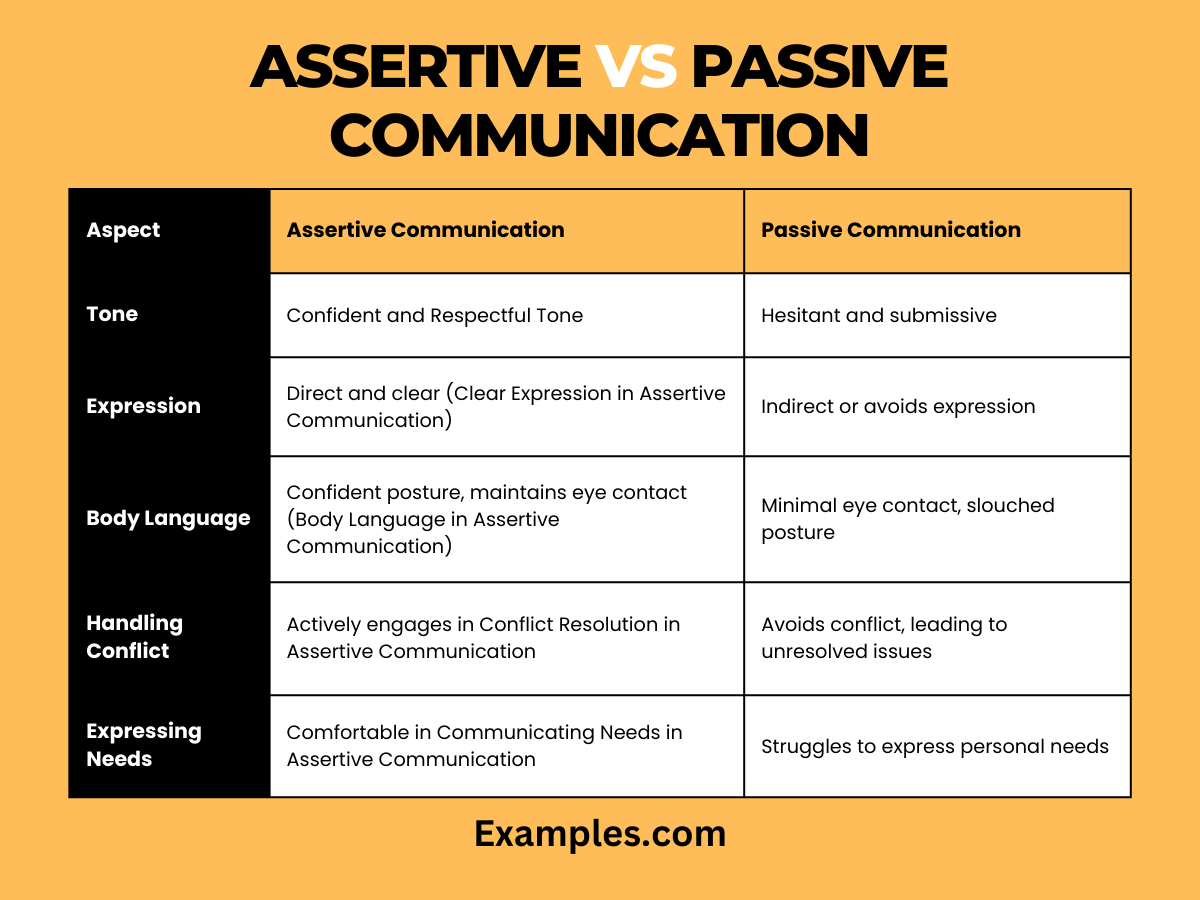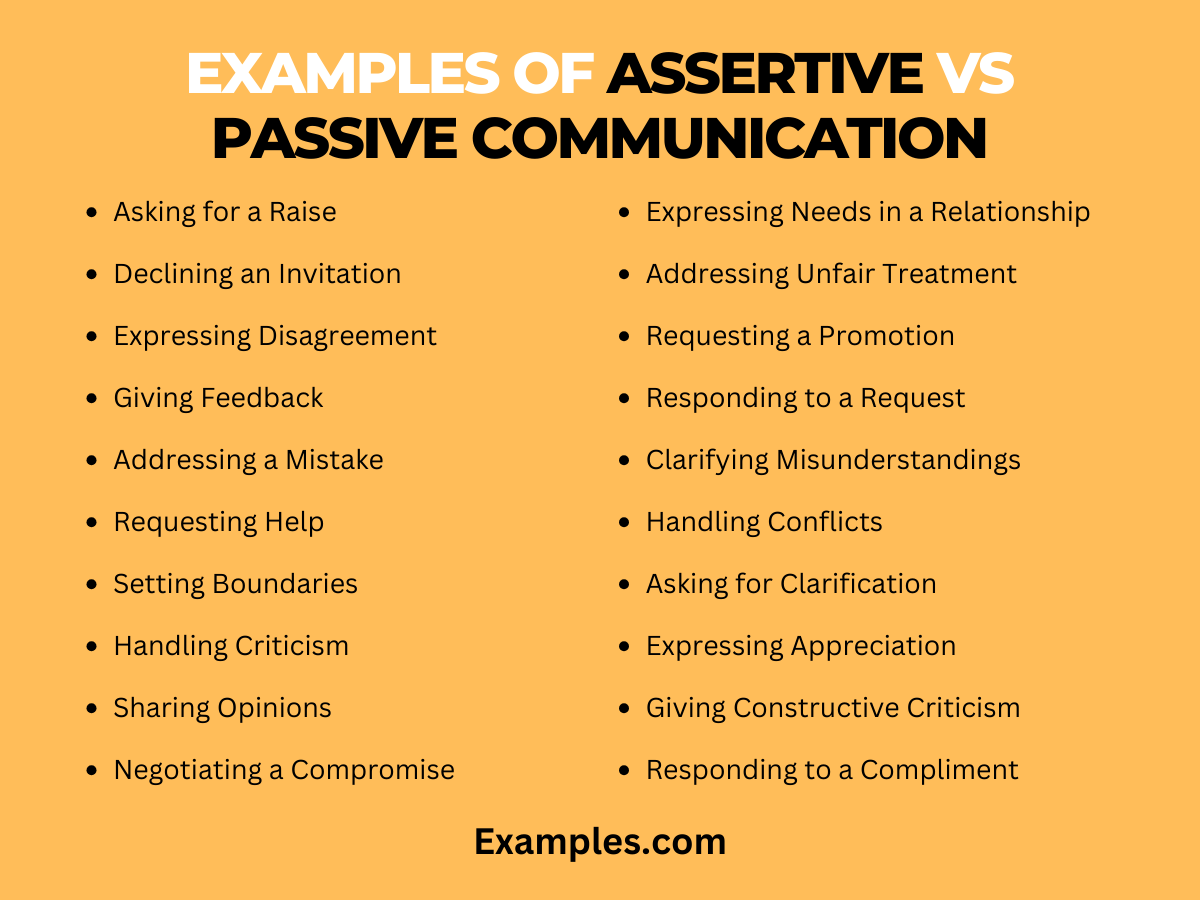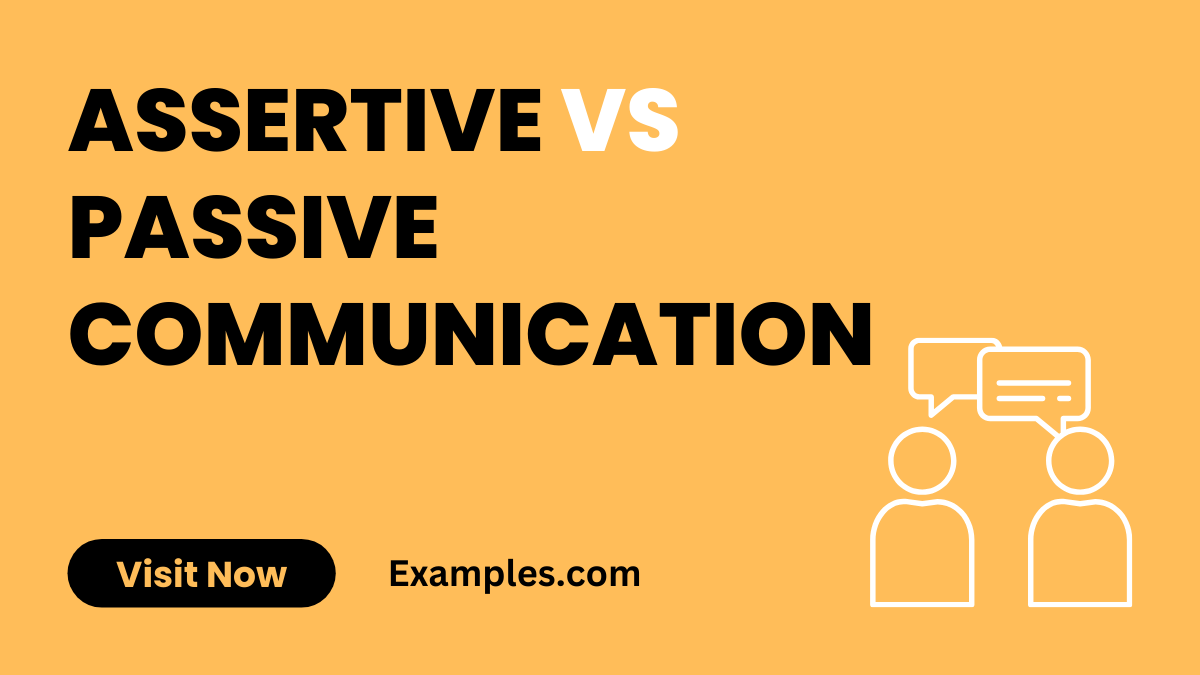Assertive vs Passive Communication – 19+ Examples
In today’s fast-paced world, effective communication is key to success in both personal and professional realms. “Assertive vs Passive Communication: A Complete Guide with Sentence Examples” delves into the nuances of these contrasting styles. This guide illuminates how different approaches impact interactions, offering a wealth of Communication Examples to illustrate each point. Whether you’re aiming to enhance your conversational skills or understand others better, this comprehensive guide provides valuable insights and practical examples to master the art of communication.
Difference Between Assertive vs Passive Communication
When comparing Assertive Communication and Passive Communication, it’s crucial to understand that these styles significantly impact how messages are conveyed and received. The following table outlines the key differences between these two communication styles:

| Aspect | Assertive Communication | Passive Communication |
|---|---|---|
| Definition | Involves expressing thoughts, feelings, and needs directly and respectfully. | Involves avoiding direct expression of thoughts and feelings, often leading to indirect or non-communication. |
| Tone | Typically characterized by a Respectful Tone and confidence. | Often quiet, hesitant, or submissive. |
| Body Language | Demonstrates Body Language in Assertive Communication such as maintaining eye contact and confident posture. | Typically involves minimal eye contact, slouched posture, and lack of presence. |
| Emotional Expression | Emotional Control in Assertive Communication is evident; emotions are expressed in a controlled, thoughtful manner. | Emotions are often suppressed or not expressed openly. |
| Response to Conflict | Engages in Conflict Resolution in Assertive Communication; seeks to address and solve issues. | Avoids conflict, leading to unresolved issues. |
| Expressing Needs | Comfortable with Communicating Needs in Assertive Communication, such as asking for help or setting personal boundaries. | Struggles to express needs; often puts others’ needs before their own. |
| Listening Skills | Employs Active Listening in Assertive Communication; listens to understand and respond appropriately. | Listening may be passive; lacks engagement in the conversation. |
| Decision Making | Makes decisions based on self-respect and respect for others; employs Solution-Oriented Approach in Assertive Communication. | Often yields to others’ decisions; struggles to express own preferences. |
| Feedback | Comfortable giving and receiving Constructive Feedback in Assertive Communication. | Often avoids giving feedback; may take feedback personally. |
| Impact on Relationships | Promotes healthy, respectful relationships; involves Assertive Communication in Relationships. | Can lead to misunderstandings and resentment due to unexpressed feelings and needs. |
20 Examples of Assertive vs Passive Communication
Understanding the distinction between assertive and passive communication is crucial for effective interpersonal interactions. Assertive communication involves expressing one’s thoughts and feelings confidently and directly, respecting both oneself and others. In contrast, passive communication entails suppressing one’s true feelings, leading to indirect and often unclear expression. This comparison highlights the differences in approach, tone, and outcome in various scenarios, providing valuable insights into the dynamics of assertive versus passive interactions.

- Asking for a raise:
Assertive: “I believe my work contributions warrant a salary increase. Can we discuss this?”
Passive: “I don’t know if it’s okay to ask, but I was wondering about a raise maybe?” - Declining an invitation:
Assertive: “Thank you for the invitation, but I won’t be able to attend.”
Passive: “I’m not sure, maybe I’ll try to make it.” - Expressing disagreement:
Assertive: “I understand your point, but I see things differently. Here’s my perspective.”
Passive: “Well, I’m not really sure, maybe you’re right.” - Giving feedback:
Assertive: “Your report was well-written, but I suggest adding more data analysis.”
Passive: “It’s just my opinion, but maybe consider adding something else to your report.” - Addressing a mistake:
Assertive: “There’s an error here. Let’s work together to correct it.”
Passive: “I don’t know if you noticed, but there might be a small mistake, perhaps.” - Requesting help:
Assertive: “Can you assist me with this task? I value your expertise.”
Passive: “It’s probably nothing, but if you’re not too busy, could you help me?” - Setting boundaries:
Assertive: “I need to focus on my work now. Let’s talk later.”
Passive: “I’m a bit busy, but I can probably chat for a minute.” - Handling criticism:
Assertive: “I appreciate your feedback and will consider it for future projects.”
Passive: “I guess I could’ve done better. Sorry.” - Sharing opinions:
Assertive: “I feel strongly that we should prioritize this project.”
Passive: “Maybe we could look at this project, but it’s just a thought.” - Negotiating a compromise:
Assertive: “Let’s find a middle ground that benefits both parties.”
Passive: “Whatever you think is best. I’m okay with anything.” - Expressing needs in a relationship:
Assertive: “I need more quality time together to feel connected.”
Passive: “It’s okay if you’re too busy for us to spend time together.” - Addressing unfair treatment:
Assertive: “I feel I’m being treated unfairly and would like to discuss this.”
Passive: “I don’t want to be a bother, but sometimes I feel a bit overlooked.” - Requesting a promotion:
Assertive: “I’ve contributed significantly and am ready for more responsibility.”
Passive: “I don’t know if it’s my place to ask, but do you think I could be promoted?” - Responding to a request:
Assertive: “I cannot commit to this as I have other priorities.”
Passive: “I’m not sure, I’ll try, but I can’t promise anything.” - Clarifying misunderstandings:
Assertive: “Let’s clarify this to ensure we’re on the same page.”
Passive: “I might be wrong, but I thought we had agreed on something else.” - Handling conflicts:
Assertive: “We have a disagreement. Let’s discuss and resolve it.”
Passive: “It’s probably not a big deal. I don’t want any trouble.” - Asking for clarification:
Assertive: “I’m not clear on this point. Could you elaborate?”
Passive: “Maybe it’s me, but I’m a bit confused. Sorry if I’m wrong.” - Expressing appreciation:
Assertive: “I really appreciate your help with this project.”
Passive: “You probably didn’t do much, but thanks anyway.” - Giving constructive criticism:
Assertive: “Your idea is good, but here’s how it could be improved.”
Passive: “Not that it’s bad, but maybe think about changing it a little.” - Responding to a compliment:
Assertive: “Thank you, I worked hard on that project.”
Passive: “Oh, it was nothing special. Anyone could have done it.”
Comparison between Assertive vs Passive Communication
To further explore the contrasts between Assertive Communication and Passive Communication, this comparison table delves into the nuances of each style. This comparison is particularly beneficial for understanding their effectiveness in different contexts, such as Assertive Communication in Nursing, Assertive Communication for Adults, and Assertive Communication at Workplace.
| Aspect | Assertive Communication | Passive Communication |
|---|---|---|
| Goal | Aims to express opinions and needs honestly while respecting others (Honesty in Assertive Communication). | Tends to avoid confrontation, suppressing personal needs and opinions. |
| Effect on Self | Builds self-confidence and self-respect (Confidence in Assertive Communication). | May lead to decreased self-esteem and feelings of resentment. |
| Impact on Others | Encourages clear and respectful understanding; positive impact on relationships (Assertive Communication in Relationships). | Can lead to miscommunication and frustration in relationships. |
| Conflict Management | Focuses on problem-solving and finding a win-win solution (Negotiating Compromises in Assertive Communication). | Avoids addressing conflict, which can lead to unresolved issues. |
| Expressing Disagreement | Comfortable with Respectful Disagreement in Assertive Communication, maintaining respect for differing opinions. | Often yields to others’ opinions, even if it leads to personal dissatisfaction. |
| Reaction to Feedback | Welcomes and utilizes feedback for improvement (Handling Criticism in Assertive Communication). | Might take feedback personally and feel hurt or defensive. |
Importance of Assertive vs Passive Communication
Understanding the importance of Assertive vs Passive Communication is key to fostering healthy interpersonal relationships and achieving personal and professional success. Assertive communication builds self-confidence and respect, while passive communication often leads to misunderstandings and unmet needs. Embracing assertiveness improves conflict resolution, enhances decision-making, and promotes a positive, respectful environment, essential in scenarios like Assertive Communication in Relationships and Assertive Communication at Workplace.
Examples of Assertive vs Passive Communication
- Asking for Clarification in a Meeting:
Assertive: “I’m not clear about this point. Can you elaborate further?”
Passive: Remains silent, leading to potential misinterpretations. - Responding to a Change in Workload:
Assertive: “I’m concerned about my ability to handle these additional tasks effectively. Can we discuss possible solutions?”
Passive: Accepts the workload silently, risking burnout and decreased performance. - Addressing a Misunderstanding with a Friend:
Assertive: “I felt hurt by what happened. Can we talk about it?”
Passive: Ignores the issue, allowing resentment to build. - Negotiating Personal Boundaries:
Assertive: “I need some personal time on weekends to recharge. Let’s plan our activities accordingly.”
Passive: Does not communicate needs, leading to frustration. - Handling Unfair Treatment:
Assertive: “I feel this decision was unfair. Can we review the reasons behind it?”
Passive: Accepts the decision without question, leading to a sense of injustice. - Requesting Assistance at Work:
Assertive: “I could use some help with this project to meet the deadline.”
Passive: Struggles alone, compromising the quality of work. - Discussing a Sensitive Topic with a Partner:
Assertive: “This topic is important to me. Can we discuss it openly?”
Passive: Avoids the conversation, preventing resolution. - Giving Feedback to a Team Member:
Assertive: “Your presentation was good, but adding more data could make it stronger.”
Passive: Says nothing, missing the opportunity for constructive improvement. - Expressing a Contrary Opinion:
Assertive: “I have a different view on this issue. Here’s my perspective.”
Passive: Goes along with the majority, suppressing personal viewpoints. - Dealing with a Complaint:
Assertive: “I understand your concern. Let’s find a solution together.”
Passive: Apologizes without addressing the underlying issue.
What is the Relationship between Assertive vs Passive Communication?
Understanding the relationship between Assertive vs Passive Communication is crucial in recognizing how different communication styles impact our interactions. Assertive communication is characterized by expressing one’s thoughts, feelings, and needs in a direct, honest, and appropriate way. It’s a balanced mix of being respectful of others while also valuing oneself. This style is often linked to Self-Control in Assertive Communication and Empathy in Assertive Communication, ensuring that the communication is neither aggressive nor submissive.
In contrast, passive communication involves a tendency to avoid direct communication, often leading to the suppression of one’s own needs and desires. Passive communicators typically struggle with expressing themselves openly, which can lead to misunderstandings and resentment over time. They might lack Confidence in Assertive Communication and might not employ Directness in Assertive Communication, which are key elements of assertiveness.
The relationship between these two styles is significant in understanding behavioral dynamics. Assertive communication often leads to healthier relationships and more effective problem-solving. It fosters respect and understanding, as individuals express their needs and boundaries clearly. On the other hand, passive communication can lead to a build-up of unspoken issues, potentially causing stress and unresolved conflicts.
In many scenarios, such as in Assertive Communication at Workplace or Assertive Communication in Relationships, striking a balance between assertive and passive styles is vital. For instance, employing Assertive Communication for Managers involves using assertiveness to lead effectively while also being receptive to feedback and team input, which can sometimes require a more passive approach.
Overall, understanding the relationship between assertive and passive communication helps individuals navigate different social and professional situations more effectively. It allows for a deeper understanding of how to communicate needs and listen to others, creating a more harmonious and productive environment.
In conclusion, the guide on “Assertive vs Passive Communication” highlights the significant impact of communication styles on personal and professional success. Assertive communication, characterized by direct, respectful expression of thoughts and feelings, fosters healthier relationships and effective problem-solving. It is a balanced approach, respecting both the communicator and the recipient??. Passive communication, in contrast, often leads to misunderstandings and unmet needs due to its indirect nature and tendency to suppress true feelings??.
For those seeking to delve deeper into the topic, the following resources provide further insights:
- American Psychological Association (APA) – This site offers a detailed exploration of assertive communication, including its psychological aspects and benefits in various settings.
- MindTools – MindTools provides practical tips and strategies to develop assertive communication skills, essential for personal growth and professional development.



